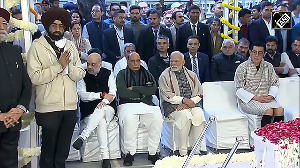American demographer Nicholas Eberstadt debunks the hype about India's demographic dividend.
Aziz Haniffa reports from Washington, DC.
Get Ahead readers -- in the 18 to 30 age group -- are often chuffed about India's supposed 'demographic dividend.'
More than half this nation's population is under the age of 30 and that, many thinkers from Nandan Nilekani to Manmohan Singh believe, will give India a clear advantage over many other nations in the world in the decades to come.
Now a leading American demographer has debunked the hype about India's 'demographic dividend.'
Armed with several slides and reams of demographic data, Nicholas Eberstadt, a senior political economist and demographer at the American Enterprise Institute -- a Washington, DC think-tank -- poured cold water on India's 'demographic dividend' that arises from more than half its population being under the age of 30 and hence the vast labour and services pool it offers India for years to come to propel its already galloping economic growth rates.
Eberstadt's data revealed that India's development was extremely uneven with stark inequalities.
While some areas and states have experienced rapidly falling birthrates and increasing levels of literacy, accompanied by rapid economic growth, he pointed out other states beset by population increases and falling education levels had continued to fall way behind.
"For all the talk of India's demographic dividend over the next two decades and that it has become a posted child of this notion," he argued that he did not believe that "one should take demographic determinism terribly far."
"If we look a little bit closer at the tableaux," Eberstadt said, "we see that there are some very significant qualifications that we have to add before thinking about India as a prospective beneficiary of this notion of demographic dividend."
"The qualifications have to do with regional diversity within India, with educational constraints, with human capital and human resource constraints," he said.
Eberstadt declared, "In India, two different Indias are being born -- two very different societies or social groupings within India."
"In the north, the outlook is for a population with a structure very much like a traditional low-income population pyramid -- like Pakistan, like Afghanistan, like Yemen. Like traditional societies."
However, in the south, he said, "something different is emerging, something that is going to look like Western Europe in the 1990s -- more labour force growth society that is starting to age demographically."
Thus, according to Eberstadt, "To oversimplify immensely the two different Indias, in the north, the baby factories and in the south, jobs and growth factories."
"The problem is, that the babies -- the young, prospective manpower -- that's being generated in the north does not have the educational qualifications to fit the demands, to fit the needs, for the job factory, the growth factory in the south."
Eberstadt, as an example, pointed to the stark contrast in educational attainment in Kerala and Bihar.
He also said, "India is about 50 years behind China in the quest to eliminate illiteracy. At this point of time, about a third of India's working age population has never been to school and on current trajectories, even 20 years from now, about almost a fifth of India's working age population will not ever have had any formal education -- not even one year of schooling."
Dismissing some of the projections, which he said were being bandied about by some of India's Planning Commission members about projections for the year 2030, that India could have a per capital output level that would be comparable to South Korea in the mid-1990s, Eberstadt implied that this was virtually delusional.
"In the mid to late 1990s, South Korea's proportion of working age population with no education was approximately zero," he pointed out. "How do you reach South Korean mid-1990s levels of per capita productivity when nearly a fifth of the workforce has never been to school? I don't see that you can. I don't know how you can."
Eberstadt said, he did not believe "anybody has thought about in any sort of sustained manner what economic inequality looks like in an India in 2030 where you have not quite as many college graduates as people with no education."
"Or to put it another way around -- almost as many people with no education as college graduates," he said, and added: "That suggests a big widening of economic differences within society unless there are compensatory policies that are undertaken more or less now -- including much more sustained push towards inclusive education."
Eberstadt noted that "of course, education has lots of other effects besides immediate productivity -- it has health effects for the family and is probably the cheapest way to improve public health. These are not things set in stone as yet, and the longer one waits, the harder they are to change."
"This is a challenge for India's development in the decades immediately ahead," he said. "It may mean that the prospect for growth would be much slower than some currently expect, absent a real rededication and commitment to turning the slogan Education for All into genuine palpable action."











 © 2024 Rediff.com -
© 2024 Rediff.com -